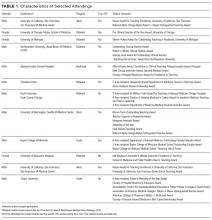Techniques and behaviors associated with exemplary inpatient general medicine teaching: an exploratory qualitative study
BACKGROUND
Clinician educators face numerous obstacles to their joint mission of facilitating high-quality learning while also delivering patient-centered care. Such challenges necessitate increased attention to the work of exemplary clinician educators, their respective teaching approaches, and the experiences of their learners.
OBJECTIVE
To describe techniques and behaviors utilized by clinician educators to facilitate excellent teaching during inpatient general medicine rounds.
DESIGN
An exploratory qualitative study of inpatient teaching conducted from 2014 to 2015.
SETTING
Inpatient general medicine wards in 11 US hospitals, including university-affiliated hospitals and Veterans Affairs medical centers.
PARTICIPANTS
Participants included 12 exemplary clinician educators, 57 of their current learners, and 26 of their former learners.
MEASUREMENTS
In-depth, semi-structured interviews of exemplary clinician educators, focus group discussions with their current and former learners, and direct observations of clinical teaching during inpatient rounds.
RESULTS
Interview data, focus group data, and observational field notes were coded and categorized into broad, overlapping themes. Each theme elucidated a series of actions, behaviors, and approaches that exemplary clinician educators consistently demonstrated during inpatient rounds: (1) they fostered positive relationships with all team members by building rapport, which in turn created a safe learning environment; (2) they facilitated patient-centered teaching points, modeled excellent clinical exam and communication techniques, and treated patients as partners in their care; and (3) they engaged in coaching and collaboration through facilitation of discussion, effective questioning strategies, and differentiation of learning among team members with varied experience levels.
CONCLUSION
This study identified consistent techniques and behaviors of excellent teaching during inpatient general medicine rounds. Journal of Hospital Medicine 2017;12:503-509. © 2017 Society of Hospital Medicine
© 2017 Society of Hospital Medicine
Clinician educators face numerous obstacles to their joint mission of facilitating learning while also ensuring high-quality and patient-centered care. Time constraints, including the institution of house officer duty hour limitations,1 shorter lengths of stay for hospitalized patients,2 and competing career responsibilities, combine to create a dynamic learning environment. Additionally, clinician educators must balance the autonomy of their learners with the safety of their patients. They must teach to multiple learning levels and work collaboratively with multiple disciplines to foster an effective team-based approach to patient care. Yet, many clinician educators have no formal training in pedagogical methods.3 Such challenges necessitate increased attention to the work of excellent clinician educators and their respective teaching approaches.
Many studies of clinical teaching rely primarily on survey data of attributes of good clinical teachers.3-7 While some studies have incorporated direct observations of teaching8,9 or interviews with clinician educators or learners,10,11 few have incorporated multiple perspectives from the current team and from former learners in order to provide a comprehensive picture of team-based learning.12
The goal of this study was to gain a thorough understanding, through multiple perspectives, of the techniques and behaviors used by exemplary educators within actual clinical environments. We studied attitudes, behaviors, and approaches of 12 such inpatient clinician educators.
METHODS
Study Design and Sampling
This was a multisite study using an exploratory qualitative approach to inquiry. This approach was used to study the techniques and behaviors of excellent attendings during inpatient general medicine rounds. A modified snowball sampling approach13 was used, meaning individuals known to one member of the research team (SS) were initially contacted and asked to identify clinician educators (also referred to as attendings) for potential inclusion in the study. In an effort to identify attendings from a broad range of medical schools, the “2015 U.S. News and World Report Top Medical Schools: Research” rankings14 were also reviewed, with priority given to the top 25, as these are widely used to represent the best US hospitals. In an attempt to invite attendings from diverse institutions, additional medical schools not in the top 25 as well as historically black medical schools were also included. Division chiefs and chairs of internal medicine and/or directors of internal medicine residency programs at these schools were contacted and asked for recommendations of attendings, both within and outside their institutions, who they considered to be great inpatient teachers. In addition, key experts who have won teaching awards or were known to be specialists in the field of medical education were asked to nominate one or two other outstanding attendings.







